Unit Code :- 1384308
Unit Title:- Plant Form and Function
B The Assignment Brief
Assignment Brief
Answer the questions below.
Where relevant you must accurately cite a range of appropriate sources of
information listed at the end of your report in Harvard format
1384308 Completion of A Work Sheet Assignment-Ascentis Awarding Organisation UK

1. a. Draw labelled diagrams of
i am transverse section of a root
ii a transverse section of shoot
iii. a vertical section of a leaf.
b. Describe the structure and function of the following types of cells
i. parenchyma
ii. sclerenchyma fibres.
2.
a. Describe the pathway of water as it moves from the roots of a plant to the leaves.
b. Explain the driving forces and resistances to this movement.
c. Briefly contrast the movement of sugars through the plant to that of water.
Hydroponics is a method of growing plants in a glass house using mineral nutrient solutions in flowing water without soil.
a. Give examples of which nutrients would need to be added to the solutions to obtain maximum plant growth. Fully explain your choice.
4. a. Consider the figure below.
Effect of two temperatures 15 o C and 25 o C and two carbon-dioxide concentrations
0.04% [low] and 0.4% [relatively high] on rate of photosynthesis at different light intensities
Rate of
photosynthesis
(arbitrary units)
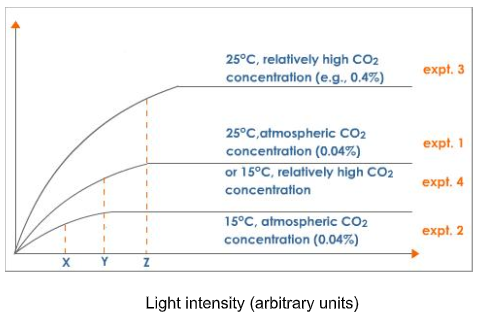
i. Explain what can be deduced about the relationship between light intensity and photosynthesis at:
increasing light intensities up to points X, Y and Z?
higher light intensities?
ii. Explain what is meant by the light compensation point?
iii. What can be deduced about the effect of carbon dioxide and temperature on photosynthesis?
iv. Discuss how other factors may influence photosynthesis.
b. Explain the role of chloroplasts in producing sugars by photosynthesis
5. Explain the reproductive process in plants and explain what happens to the flower after pollination.
6. Plant growth regulators are chemical messengers in plants Name any two plant growth regulators and discuss their action.

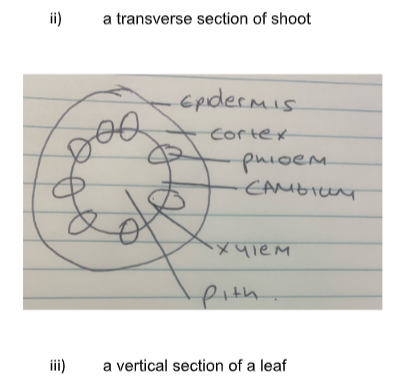
1b) i) Parenchyma is a tissue in plants which is composed of mostly living cells that have thin walls. They are unspecialised in structure so they are adaptable to various functions.
The cells are found in many areas through plant bodies and they are actively involved in photo synthesis food storage secretion and other plant activities The most important function of a Parenchyma cell is that of healing and repair.
They have a unique meristematic nature as they have the ability to divide into a number of different cells When Parenchyma cells are exposed to the outside of a wound that is when they are stimulated to divide. They divide towards the wound and differentiate it into the appropriate cell types such as the epidermis or the bark.
The Parenchyma cells that are on the inside of the wound are undifferentiated and they provide a source of meristematic cells in case of another attack to the plant. Parenchyma cells also play an important role in nutrient and food storage. As humans we need Parenchyma cells This is because we rely on the storage ability of the cells as our main source of food. The largest central vacuole within the plant cell allows them to store large quantities of soluble nutrients. The plant controls how much nutrients to use and distribute with in the cells. Parenchyma cells are a major storage place for water ions and all photosynthesis products. Parenchyma is one of the three main types of fundamental tissue in plants along with sclerenchyma and collenchyma.
1384308 Completion of A Work Sheet Assignment-Ascentis Awarding Organisation UK
A parenchyma cell has a prominent nucleus and proto plast The cells of parenchyma are iso diametric in shape. They may be elongated round polygonal or oval. Parenchyma cells are closely packed and could have intercellular spaces. They have some small vacuoles and water is present in the vacuoles that act as a water reservoir. Some parenchyma cells may have a thick lignified wall which may make it difficult to differentiate them from sclerenchyma. The hydraulic property of these cells gives the parenchyma the mechanical strength. In the parenchyma cells chloroplasts are present that are specified to perform photosynthesis. Parenchyma cells also have a dense protoplasm which is rich in Golgi bodies ribosomes and a highly developed endoplasmic reticulum.
As parenchyma cells have intercellular spaces it is used for storage They can store fats water and oil droplets. Parenchyma cells transport nutrients and other chemicals and the xylem parenchyma helps in radial transportation of water and minerals. Some of the cells transport light from the surface to cells which are underground. Chlorenchyma which is present in the mesophyll and the other green parts of the plant have chloroplasts and perform photosynthesis. The aerenchyma cells help in the gas exchange within plants. Parenchyma cells which retain their ability to divide help with regeneration and wound healing. The tyloses which are present in the xylem parenchyma helps prevent damage to vascular tissues in the condition of drought.
ii. Sclerenchyma fibres in plants support the tissue composed of a variety of hard woody cells Mature sclerenchyma cells are composed of dead cells that have thick walls which contain lign in. The cells don’t stretch and they are rigid. They are usually found in plant bodies which are non-growing such as the bark. Sclerenchyma cells are one of the three main tissues in the plant. Sclerenchyma cells come in many different types and sizes but the two main ones are: fibres and sclereids.
Sclerenchyma fibre cells are composed of Lumen and a thick cell wall. The lumen is an empty space which is present between the cells. They are referred to the cavity of the cell. The lumen extends throughout the cell and gives the cell rigidity and support. Sclerenchyma cells have a high cellulose content which is between 60%-80%.
The function of a sclerenchyma cell is to provide structural support in plants.
2) a) The three ways in which water moves from one plant cell to another are: vacuole symplastic and apoplastic. Through osmosis the water (H2O) moves into the root hair down the concentration gradient. Water enters the root hair cell only if the water potential which is outside the root, is higher than the potential inside the root. When there is more solute present, the water potential is lowered. This is because more molecules are dis solved into the water such as potassium nitrates and amino acids. When the water moves via osmosis it will be too slow and the plant will need water faster. This is done by ATP and it is converted to ADP. ATP is important in this stage and this is done by using the stored starch which is broken down into glucose to provide ATP and to allow respiration to occur. The mineral ions will be actively transported into the root hair cell so more water can be transported by using osmosis into the cell.
The water then reaches the root hair cell and it moves through the cortex by osmosis going towards the endodermis. To make the protein shape change ATP is used so that it will allow the movement of ions from the cortex into the endodermis. When the mineral ions go into the endodermis they are transported into the xylem. All the stages of mineral ions travelling from one plant cell to the other allows osmosis to transport the water. As the mineral ions travel through each stage the water potential is lowered. This means that the water cannot can’t move through out the cell without the mineral ions moving first because of the concentration gradient. The water can move through three pathways the symplast pathway vacuole pathway and the apop last pathway. The cytoplastic route allows the water to travel through the cortex along the wall of the cell. The apoplastic route allows water to travel in between the inter cellular spaces from the root hair cell epidermis to the endodermis. Both of these routes are taken via the cortex vacuolar pathway. When the water goes through these pathways they reach the casparian strip. The casparian strip is wrapped around the cell in one direction and it is hydrophobic which makes the water go up the plant as it doesn’t allow the water go in any wrong direction. The casparian strip stops the movement of water in the apoplast route and forces it into the cyto plast route into the xylem. The water then reaches the xylem and it travels throughout the plant as the xylem is a tube like structure which goes up the plant stem. The movement of water from the xylem to the stem is done by the cohesion tension theory which allows the transpiration pull. When the water is lost in the leaves through transpiration a tension is caused because the water molecules are attached to each other and creates the transpiration pull from the water in the xylem to add more water to the leaves.

B) Osmosis uses the difference in concentrations of nutrients between the root and soil to move water and nutrients into the plant. In the centre of the root there are more minerals and nutrients than in the outside of the root. This is an area called the ‘stele’ or ‘vascular cylinder’. The nutrients and water keep moving toward the centre of the root and into the stem. During the osmosis process water moves from an area of lower concentration to the area of higher concentration.
Once the nutrients and water are inside the xylem, adhesion and cohesion continue to move the water up the plant. Adhesion occurs when the water molecules cling onto the xylem tissue. The force to pull water up the side of the tube in the xylem is provided by adhesion.
The cohesion-tension theory suggests that water is gained in the plants from the soil because water is cohesive and it is able to be drawn up from soil particles into the route hairs by the process of osmosis. Water then moves through the neighbouring cortex cells via osmosis until it reaches the xylem cells. Water is able to travel up the xylem because of the tension that is created. When water exits the plant because of transpiration, the water is drawn up from the root so that the plant has a constant supply of water.
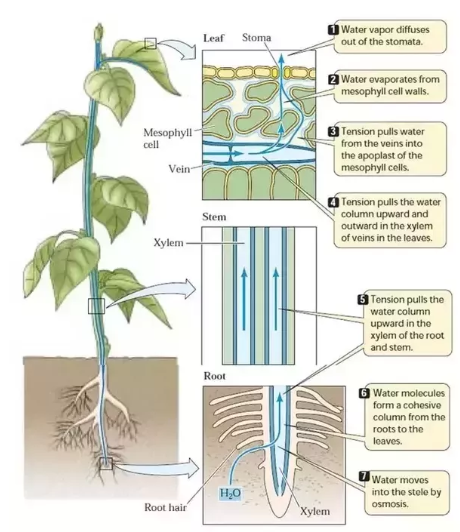
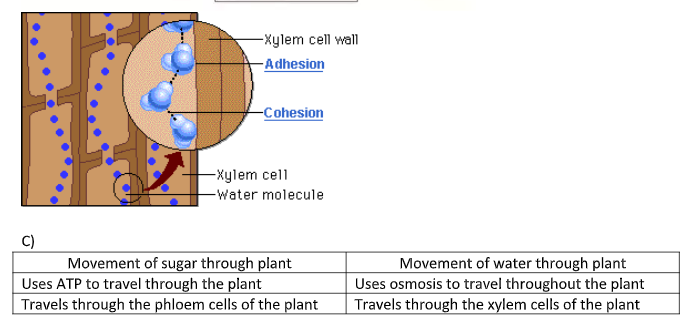
Q3) a) Auxin is involved in cell growth and cell expansion. It is produced in the parts of the plant that are actively growing such as the tip of the stem and the root. Auxin is trans ported in one direction in a plant downward from the top to the bottom. It is the only plant hormone which is known to do this which is why the concentration of auxin is highest at the top of the plant and as you get closer to the roots it decreases. Auxin helps control the overall shape of the plant and helps keep the primary stem of the plant.
Gibberellins causes similar effects as auxin but it is a different hormone. Gibberellins were originally dis covered in Japan. Gibberellins plan an important role in several development stages in plants but
they are known for making stems longer. They promote stem elongation between nodes and the stem. A node is a place on the stem where a leaf is attached so gibberellins elongate the internodes.In dwarf and rosette plants, you can easily spot the absence of gibberellins as there is very little space between nodes on a stem and the leaves are clustered towards the base of the plant.
Q4) a) i) At X, Y and Z the relationship between photosynthesis and light shows that the rate of photosynthesis is increased when light is increased. This is due to the light intensity increasing. When the light intensity is high, photosynthesis increases whereas if it very high the rate of photosynthesis slows down.
Ii) The light compensation point is the light intensity at which the amount of carbon dioxide released in respiration equals the amount which is used in photosynthesis and the amount of oxygen which is used in respiration is equal to the amount which is released in photosynthesis. This is varying in a variety of different plants and in response to changes in environmental factors such as changes in temperature.

1384308 Completion of A Work Sheet Assignment-Ascentis Awarding Organisation UK

Iv) Many factors can have an influence on photosynthesis light intensity temperature and carbon dioxide concentration. If a plant does not get enough light the plant cannot photosynthesise as quick even if they have plenty of water and carbon dioxide. The light intensity boosts the rate of photosynthesis.
An increase in the carbon dioxide concentration increases the rate in which carbon is in corporated into carbohydrates with the light dependent reaction. This makes the rate of photosynthesis increase.
Low temperatures can limit the rate of photosynthesis as the number of molecular collisions between the substrates and enzymes decreases. High temperatures cause the enzymes to become denatured therefore not allowing photosynthesis to take place.Factors affecting the rate of photosynthesis – Photosynthesis – OCR Gateway – GCSE Biology Single Science Revision – OCR Gateway – BBC Bitesize, 2020)
Light dependant reactions (LDS) use light energy to make the energy storage molecule ATP and the reduced electron carrier (NADPH). The light reactions take place in the thylakoid membranes of the organelles called chloroplasts.
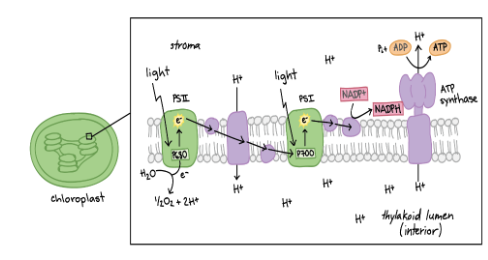
In plants carbon dioxide enters the interior of a leaf through the pores which are called the stomata and they diffuse into the stroma of the chloroplasts. This is where Calvin cycle reactions take place and also where sugar is synthesized. These reactions are called light-independent reactions due to the fact that they are not driven by light. The Calvin cycle reactions can be divided into three main stages. These are carbon fixation, reduction and the regeneration of the starting molecule. Carbon atoms from the CO2 are fixed and they are used to build three-carbon sugars. This process is dependent on the products of the light dependant reaction; ATP and NADPH. The Calvin cycle takes place in the stroma.
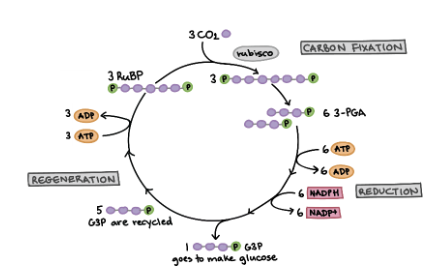
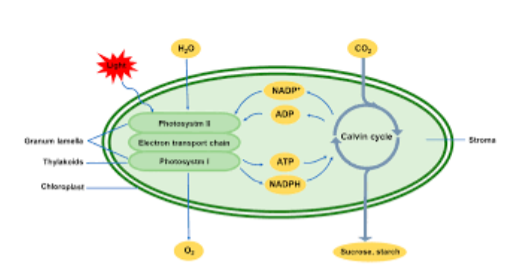
Q5) The female reproductive structure is made up of two parts The two parts are the anther and the fila ment. The anther is where the pollen is produced and the filament supports the anther. The female reproductive system is made up of three parts the style the superior ovary and the stigma.The stigma is at the top of the reproductive structure and it is sticky so pollen can stick to it. Plants that contain both male and female plants together are called hermaphrodite plants. Fertilization occurs when the anther releases the pollen which sticks to the stigma allowing it to travel down the style into the ovule. The pollen is a male gamete and the ovule is the female gamete. The male and female gametes fuse together to create the zygote which then creates an embryo. The seed is then created by the ovule. After the fertilization process, seed dispersal occurs.
The seed may dispute further away from the plant or close by depending on a number of factors such as wind animals and explosions.These factors are important because other wise the plant will grow right next to the parent plant which may cause a stunt in the growth of the plant as there is not enough room for development.
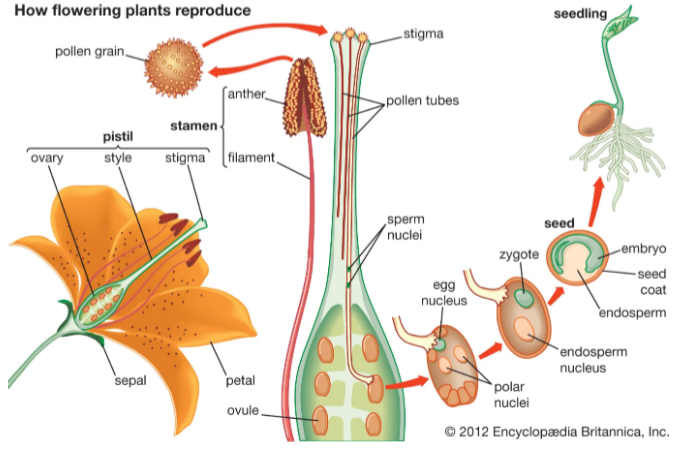
1384308 Completion of A Work Sheet Assignment-Ascentis Awarding Organisation UK
Q6) A plant growth regulator (PGRs) are chemicals which are used to modify the growth of plants e.g supressing shoot growth increasing branching or return bloom removing excess fruit, or altering the maturity of the fruit. The performance of the PGR is affected by numerous factors such as weather conditions dose timing and tree age and vigour.
An example of a PGR is Cytokinin's. Cytokinin's promote the division of cells. They are involved in stimulating and branching bud initiation. Cytokinin' s are used as fruit thinners in apples. Another example is a Absicsic acid. Absicsic acid controls the dormancy of seeds and buds. It is involved in regulating water loss from plants and it also inhibits shoot growth.
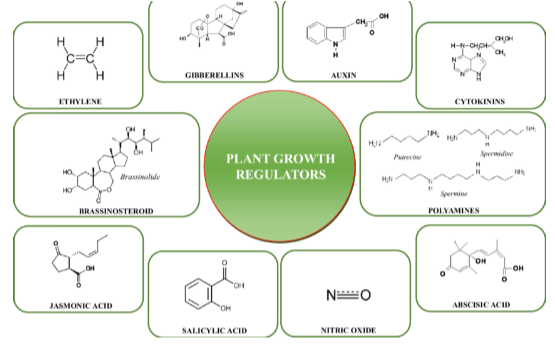
ORDER This 1384308 Completion of A Work Sheet Assignment NOW And Get Instant Discount
Read More :-



